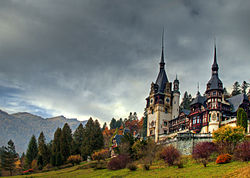
Back Turisme a Romania Catalan Tourismus in Rumänien German Turismo en Rumania Spanish Románia turizmusa Hungarian Զբոսաշրջություն Ռումինիայում Armenian Turismo in Romania Italian რუმინეთის ტურიზმი Georgian Turismul în România Romanian การท่องเที่ยวในประเทศโรมาเนีย Thai Romanya'da turizm Turkish




In December 2024, Romania's tourism sector had a 6.8% increase in arrivals at accommodation facilities, including hotels, apartments, and rental rooms, compared to December 2023.[1] in authorized lodging facilities, marking increases of 4.5% over 2023[1] Overnight stays also rose by 4.9% during the same period. At border crossing points, Romania recorded 916,100 foreign visitor arrivals, while the number of Romanian residents traveling abroad reached 1,007,600.[1]
In 2024, the National Institute of Statistics reported that Romania recorded over 14 million arrivals[1] in authorized lodging facilities, marking increases of 4.5% over 2023[1] and 7.7% compared to 2019,[1] with overnight stays reaching 30.2 million.[1] Early trends for 2025 continue to reflect strong domestic interest, particularly along the Romanian Black Sea resorts and in emerging sectors such as Ecotourism.[2]
The most visited cities are Bucharest, Constanța, Brașov, Timișoara, Sibiu, Alba-Iulia, Cluj-Napoca, Sighișoara, Iași and Oradea. Natural touristic attractions include the Danube, the Carpathian Mountains, and the Black Sea. The most popular destinations for tourists are the capital city Bucharest, Brașov County, Cluj County, Prahova County, Constanța County, Bihor County and Sibiu County.[3]
- ^ a b c d e f g "Turismul în luna decembrie 2024" (PDF). insse.ro. Retrieved 9 February 2025.
- ^ Jifcu, Ionuţ. "Turismul românesc în 2024: Creștere semnificativă și tendințe favorabile pentru 2025". Gazeta Noua. Retrieved 22 February 2025.
- ^ "Bihor, locul 6 în topul celor mai vizitate județe din țară".
© MMXXIII Rich X Search. We shall prevail. All rights reserved. Rich X Search